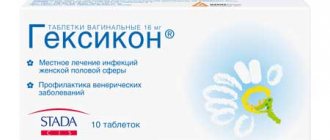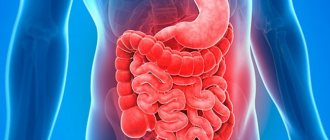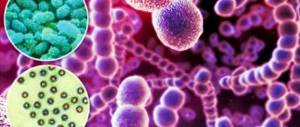Nizoral tablets - instructions for use
Nizoral tablets are an oral antifungal drug intended for the treatment of skin lesions, lesions of the mucous membranes and nail plates. The medicine is effective against certain types of yeast fungi (including against the causative agents of candidiasis), is prescribed for fungal infections of the nails and scalp (dandruff), as part of the systemic therapy of mycoses, candidiasis and seborrhea.
Compound
The drug Nizoral is available in tablet form, as well as in the form of a cream for external use and shampoo against seborrhea. Each flat, round, white tablet contains about 200 mg of the active ingredient - ketoconazole. The drug is packaged in 10 tablets per blister, 1, 2 or three blisters per cardboard box. Instructions for use are included with each package. The full composition of the product is presented in the table below.
| Active substance | Content, mg |
| Ketoconazole | 200 |
| Corn starch | 80 |
| Lactose monohydrate | 19 |
| Povidone K90. | 6,6 |
| Microcrystalline cellulose | 3 mg |
| Colloidal silicon dioxide | 0,7 |
| Magnesium stearate | 0,7 |
Pharmacological properties
Nizoral tablets have an antifungal effect, their active ingredient ketoconazole has a fungicidal effect against pathogens of fungal infections, effectively resists the proliferation of yeast fungi, fungi that provoke vaginal and systemic candidiasis, seborrheic dermatitis. Fungal infection is stopped by suppressing the synthesis of ergosterol, which is necessary for the formation of fungal cell walls.
After oral administration with food, the maximum concentration of ketoconazole in the blood plasma occurs after 1.5-2 hours. The substance is distributed evenly throughout the fluids and tissues of the body, in small quantities (about 1.5%) penetrates into the structures of the central nervous system (cerebrospinal fluid) through the blood-brain barrier. Absorption decreases with reduced gastric acidity and increases when taking the tablets on an empty stomach with drinks containing acid. Metabolized by the liver, excreted in urine, bile and feces.
- 4 recipes for lightly salted cucumbers in a three-liter jar
- Fashionable looks from foreign pensioners
- 5 best clinics for joint treatment
Indications for use
Taking Nizoral tablets is prescribed for the prevention and treatment of various fungal infections of the skin and nails, in cases where topical agents are not effective enough. The drug is prescribed for:
- dandruff prevention;
- treatment of vaginal candidiasis;
- treatment of fungal meningitis;
- treatment of nail fungus;
- treatment as part of complex therapy of systemic mycoses.
Indications for use of Nizoral
Nizoral tablets are used to treat: fungal infections of the gastrointestinal mucosa, chronic thrush, mycoses of the nails, skin, soft tissues, systemic mycoses, to prevent fungal infections in patients with a weak immune system, for example, after undergoing chemotherapy.
The cream is used externally for pityriasis versicolor, seborrhea, inguinal athlete's foot, cutaneous mycosis and dermatomycosis caused by the Candida fungus, athlete's foot.
Nizoral shampoo is effective for seborrheic dermatitis (dandruff), lichen versicolor.
Nizoral suppositories are used according to the instructions for the treatment of thrush.
Directions for use and dosage
Nizoral tablets are taken orally with meals to improve absorption. If indicated, it may be recommended to take it together with drinks that increase the acidity of gastric juice. The dosage regimen and duration of treatment are developed by the attending physician depending on the type of fungus, the degree of damage and the individual characteristics of the patient’s body. The recommended daily dose of ketoconazole is 200 mg/day (1 tablet); for vaginal candidiasis, it can be increased to 2 tablets. The duration of treatment ranges from 2 weeks to 6 months.
Effective drugs for thrush in women
- Types of drugs for thrush
- Nystatin
- Natamycin
- Fluconazole
- Itraconazole
- Zalain
- Ketoconazole
- Flucostat
- Diflucan
- Livarol
- Irunin
- Clotrimazole
- Lomexin
- Treatment of chronic thrush
- Treatment of chronic thrush during pregnancy and breastfeeding with drugs
Thrush (candidiasis) is a disease caused by the Candida fungus. Up to 80% of people are its carrier, but under favorable conditions it begins to multiply, causing unpleasant symptoms.
The appearance of fungus can be caused by disturbances in the functioning of the immune or endocrine system, taking antibiotics or wearing synthetic underwear. Thrush can be transmitted through sexual contact.
In women, it manifests itself in the form of cheesy discharge, itching and burning in the vaginal area and external genitalia, as well as an unpleasant odor. To treat thrush, antifungal drugs are prescribed.
In this article we will look at popular drugs for the treatment of thrush in women.
Types of drugs for thrush
To treat thrush in women, use:
- Polyene antibiotics. Such remedies for thrush for women include Nystatin. It is available in the form of tablets, suppositories or ointments. This is one of the first antifungal drugs that disrupts the cellular structure of the fungal membrane. Since the bioavailability of Nystatin is no more than 5%, suppositories are prescribed simultaneously with tablets for the treatment of thrush;
- Triazoles: Fluconazole, Flucostat, Diflucan. These thrush medications for women inhibit the synthesis of ergosterol. Since they are well absorbed and act for a long period, they are used in the form of capsules or tablets for oral administration;
- Imidazoles: Ketoconazole (Nizoral, Dermazole), Clotrimazole. Ketoconazole is available in the form of tablets, suppositories, ointments, creams or shampoos. It has a pronounced fungicidal effect. Clotrimazole is not used orally; it is used in the form of cream, ointment or suppositories;
- Macrolides: Pimafucin, Natamycin. Medicines for thrush in women are available in the form of cream, suppositories or tablets. Their main advantage is that when applied topically they are not absorbed into the systemic bloodstream, which allows the use of suppositories by pregnant and lactating women;
- Combined products: Terzhinan, Polygynax. In addition to the antifungal component, they contain anti-inflammatory agents.
Nystatin
Nystatin belongs to the group of polyene antibiotics. It has been used for the treatment of thrush for a long time. The active ingredient of the drug binds to the sterols of the cell membranes of the fungus, which leads to an increase in their permeability and death.
To treat the disease, vaginal suppositories of 0.5 million units are used, which are used twice a day for 10–14 days.
For chronic thrush, they are combined with Nystatin tablets of 0.25 million units, which are taken orally 4 times a day.
Nystatin is part of such drugs as Terzhinan, Polygynax and Macmiror.
Natamycin
Natamycin, like Nystatin, belongs to the group of polyene antibiotics. The drug is produced in the form of cream, tablets and vaginal suppositories. The drug inhibits the reproduction and growth of the fungus (has a fungistatic effect).
Suppositories of 100 mg, administered once a day before bedtime, for a week. For re-infection or severe disease, use 1 tablet of 100 mg 2 to 4 times a day.
Analogues of Natamycin are Pimafucin, Primafungin.
Fluconazole
Fluconazole is an azole derivative antifungal drug that is an effective treatment for thrush for women. Its use leads to disruption of the biosynthesis of ergosterol and cholesterol in the plasma membrane of the fungus. Fluconazole has a fungistatic effect.
Fluconazole is available in the form of tablets or capsules of 50, 100, 150 or 200 mg. In order to get rid of candidiasis, if the disease is not chronic and not complicated, a single use of the drug in a dosage of 150 mg may be necessary.
In other cases, it is necessary to take 150 mg of Fluconazole orally on the 1st, 4th and 7th day, then 1 capsule on the first day of menstruation.
In case of frequent exacerbations, after use according to the standard regimen, you must take 1 capsule once a week for 6 months.
Fluconazole is highly bioavailable and has minimal side effects. Its disadvantage is that over time, the causative agent of candidiasis may become insensitive to the drug.
Analogs of Fluconazole are Difluzol, Diflucan, Fucis, Tsiskan, Flucostat.
Itraconazole
Itraconazole belongs to the azoles group. It has a fungistatic effect, preventing the proliferation and growth of fungus. The drug is available in the form of tablets or capsules for internal use.
To treat thrush, take 200 mg of Itraconazole twice a day for 24 hours.
If the disease is chronic, then treatment should be continued and take 400 mg of the drug divided into 2 doses for 3 days.
For the treatment of fungal vulvovaginitis, the drug is taken according to the previous regimen, for a week, and then 200 mg once a day on the first day of menstruation.
Analogs of Itraconazole are: Itracon, Iconazole, Itral, Sporagal.
Zalain
Zalain is classified as a derivative of imidazole and benzothiophene, a medicine for candidiasis. It destroys the fungus and prevents colonies from multiplying. Zalain is available in the form of 300 mg suppositories.
To treat thrush, one Zalain suppository is inserted into the vagina at night, once.
If necessary, treatment can be repeated after a week. The drug can be used during menstruation.
Ketoconazole
Ketoconazole is a fairly well-known drug, which is classified as an azole derivative, and is an anti-thrush remedy. It is produced in the form of tablets, suppositories or ointments.
Ketoconazole has a fungistatic effect. And when applied topically, there is a high concentration of the drug.
To treat thrush, one Ketoconazole suppository is inserted into the vagina before bed. Depending on the severity of the disease, treatment can be continued from 3 to 10 days.
In case of complicated or chronic disease, Ketoconazole tablets are taken orally, 0.2 g twice a day or 0.4 g once a day during meals. The course of treatment is on average 7 days.
Analogues of Ketoconazole are Dermazol and Nizoral.
Flucostat
The main active ingredient of Flucostat is fluconazole, which is a triazole derivative. It inhibits the synthesis of sterols in the cells of fungi from the genus Candida or cryptococci that are sensitive to the drug.
The drug is rapidly absorbed, and its half-life is up to 30 hours. To treat thrush, it is most often used once in a dosage of 150 mg. To reduce frequent relapses of the disease with more than 3 episodes per year, take 1 capsule (150 mg) of Flucostat once a month. The duration of therapy can be from 6 to 12 months, depending on the severity of the disease. In some cases, the frequency of administration can be increased.
Diflucan
Diflucan contains fluconazole. This triazole derivative inhibits the synthesis of ergosterol in the cell membranes of the fungus. The drug is used to treat thrush, including the chronic form of the disease.
In order to get rid of the disease, a single dose of Diflucan is required at a dose of 150 mg. In severe cases of the disease, the drug is taken on the 1st, 3rd, 7th day and an additional one capsule on the first day of menstruation.
In the chronic form of the disease, Diflucan is taken 150 mg once a month. The number of appointments can be increased if necessary. It is not recommended to take the drug during pregnancy and lactation.
Livarol
The active ingredient of Livarol is ketoconazole. It belongs to the group of imidazoles and has a pronounced antifungal effect. The drug is used to treat acute and chronic forms of candidiasis in women, as well as for diseases caused by mixed infections.
In order to get rid of thrush, a candle is placed in the vagina once a day before bedtime. Treatment lasts from 3 to 10 days, depending on the form of the disease and the frequency of its relapses.
Pregnant women can use the drug in the second and third trimester, as prescribed by a doctor.
Irunin
The active ingredient of Irunin is itraconazole (an antifungal substance from the triazole group). It negatively affects the cell membranes of fungi, causing their death. The drug has a wide spectrum of action and effectively copes with yeasts and molds, as well as dermatophytes.
To treat thrush, 100 mg of the drug is prescribed twice a day for one day. You can also use 100 mg once a day for 3 days.
In order to get rid of the disease, you can use vaginal tablets. They are inserted into the vagina once a day before bedtime. Treatment is continued for 7 to 14 days, depending on the severity of the infection.
Clotrimazole
Clotrimazole is one of the most well-known drugs for candidiasis in women. It belongs to imidazole derivatives and has a fungistatic effect. The drug disrupts the biosynthesis of ergosterol in the membrane of the fungus, thereby destroying it.
Clotrimazole is not taken orally. It is produced in the form of a cream or vaginal tablets of 0.1 g.
To treat thrush with clotrimazole, 1 tablet is inserted into the vagina at night.
It is also recommended to lubricate the perineum with Clotrimazole cream during treatment. The course of treatment is from 7 to 14 days.
The effect of using the drug becomes noticeable within 3 days, but treatment must be continued, since premature cessation can lead to the disease becoming chronic.
Analogues of Clotrimazole are Candide, Kanesten, Kanespor.
Lomexin
The active ingredient of Lomexin is fenticonazole. It has both fungicidal and fungistatic effects.
It inhibits the production of ergosterol, which is part of the cell membranes of fungi, disrupting the ability of fungal cells to reproduce.
The drug is produced in the form of capsules of 600 and 1000 mg or cream. It acts only locally, so the capsules are not taken orally, but inserted into the vagina.
To treat thrush, 1 capsule taken before bed may be enough. If necessary, another capsule of Lomexin is administered after 3 days.
Treatment of chronic thrush
In order to get rid of chronic thrush, it is first necessary to restore the functioning of the immune system. To do this, you need to lead a healthy lifestyle, eat right and consult a doctor on time in order to prevent the occurrence of other chronic diseases.
For chronic thrush, Fluconazole (Diflucan, Difluzol, Mikosist) is used.
This drug is taken 150 mg on the 1st, 3rd and 5th day of exacerbation of the disease, as well as on the first day of the onset of menstruation. For frequent relapses of the disease, 150 mg of Fluconazole is prescribed once a month for 4 to 12 months.
For chronic thrush, Intraconazole can be prescribed, which should be taken 200 mg 2 times a day for 3 days.
Additionally, drugs are prescribed in the form of suppositories: Pimafucin, Zalain, Polygynax, Nystatin.
Your doctor will help you choose the best remedy for thrush in women!
Treatment of chronic thrush during pregnancy and breastfeeding with drugs
The causes of thrush include changes in hormonal levels and weakened immunity that accompany pregnancy and lactation.
One of the most effective and safest remedies is Pimafucin suppositories. The active ingredient of the product is the polyene antibiotic natamycin, which disrupts the integrity of the cell membranes of the fungus.
When applied topically, the drug is not absorbed through the skin and mucous membranes, therefore it does not penetrate the systemic bloodstream and does not pass into breast milk. They are inserted deep into the vagina before bed. Use 1 suppository per day for 3 to 9 days, depending on the severity of the disease.
In the second and third trimester of pregnancy, you can use Terzhinan, Livarol or Clotrimazole suppositories.
Now you know how to treat thrush in women and what popular medications to take for this.
| Did the article help you? : |
special instructions
During the course of treatment with Nizoral tablets, laboratory monitoring of the functional activity of the patient's liver and adrenal glands is necessary, due to the high hepatotoxicity of the drug. The active substance of the drug interacts with substances of other pharmacological groups, therefore the attending physician must be notified by the patient about the parallel use of any other drugs. It is not prescribed during pregnancy due to the ability of ketoconazole to cross the placental barrier, which is a risk for the normal development of the fetus.
Composition and release forms
The drug Nizoral in any form of release has high antifungal properties
Nizoral is a fungal remedy available in three dosage forms:
- flat, round tablets with a beveled edge and a scoring line. Available in blisters of 10 capsules, each containing 200 mg of active ingredient;
- cream for topical use, white in color and uniform in structure, available in aluminum tubes of 15 g. Concentration of the active substance - 2% (20 mg);
- The shampoo is red-orange in color and is available in polyethylene bottles of 25 or 60 ml. The concentration of the active substance is 2% (20 mg).
The drug contains a synthetic biologically active substance - ketoconazole, as well as auxiliary components: purified water, dyes, flavors, cellulose, starch, fatty acid derivatives.
Drug interactions
The CYP3A4 isoenzyme is involved in the metabolism of ketoconazole. The pharmacokinetics of ketoconazole may be affected by other substances with the same metabolic pathway or those affecting the activity of cytochrome P450. Ketoconazole may also affect the pharmacokinetics of other substances with the same metabolic pathway. Ketoconazole is a potent inhibitor of cytochrome P450 CYP3A4 and P-glycoprotein. When carrying out concomitant therapy, it is necessary to read the relevant instructions for use to obtain information about the route of their metabolism and the possible need for dose adjustment.
- How to save money for old age abroad
- What does Balzac age mean in women?
- What will happen to military pensions in 2020
Side effects and overdose
In case of an overdose of Nizoral tablets, a number of strong negative reactions from the nervous, digestive, and respiratory systems are observed. Side effects may also occur if there is an individual intolerance to the components of the drug. Therapy should be stopped if the following symptoms occur:
- abdominal pain, vomiting, diarrhea, nausea, jaundice, symptoms of toxic and holicistic hepatitis, liver failure;
- dizziness, headaches, weakness, increased fatigue, insomnia;
- allergic reactions on the skin (urticaria, erythema, dermatitis), anaphylactic shock;
- fever or chills.
Shampoo composition and active ingredients
The main active ingredient is ketoconazole, a substance that fights fungus. It disrupts its structure, preventing it from developing and spreading further. The fungal shell produces ergosterol, which leads to skin breakdown. Ketoconazole slows down this process and reduces the permeability of the cell membrane. The amount of this substance in Nizoral is 2%.
The active component affects:
- yeast fungi (Candida, Pityrosporum, etc.);
- dermatophytes;
- dimorphic fungi;
- zoumicetes.
READ ALSO: For the treatment of baldness, Rinfoltil shampoo: reviews and application regimens to achieve the desired result
In addition to ketonazole, Nizoral shampoo includes auxiliary components:
- lauryl sulfate diethanolamide for foam formation;
- collagen hydrolyzate;
- NaCl;
- macrogol methyldextrose dioleate – has a calming effect, relieves itching and irritation;
- HCl dissolves ketonazole (can sometimes cause an allergic reaction);
- Imidourea – has an antimicrobial effect.
Possibility of side effects
The only contraindication for Nizoral shampoo is individual intolerance to certain ingredients of the product. Allergic reactions occur only rarely. They can manifest themselves in the form of itching, skin rashes, swelling of the tongue, throat, and dizziness.
The effect of Nizoral is quite mild on the skin. But sometimes you can see:
- changes in the texture of the strands and their shade (usually this occurs on gray and chemically damaged hair);
- acne on the surface of the scalp;
- excessive oiliness or dryness of the dermis and hair.
Once you stop using the shampoo, these symptoms usually go away.
Contraindications
Children under three years of age, pregnancy and lactation in women, individual intolerance to the components of the drug, chronic or acute liver diseases, lactose intolerance are conditions for which taking Nizoral tablets is not recommended by the manufacturer. The remaining strict contraindications are associated with drug interactions of ketoconazole with other pharmacological substances. Concomitant use with:
- Bepridil;
- Astemizole;
- Halofantrine;
- Disopyramide;
- Dofetilide;
- Sertindole;
- Quinidine;
- Dihydroergotamine;
- Methylergometrine;
- Ergotamine;
- Everolimus;
- Eplerenone.
Nizoral analogue
The prescription of the drug against fungal infection is made by a dermatologist; independent replacement of it in the presence of individual intolerance to the components of the drug or other contraindications is unacceptable. If there are negative side effects during therapy, the patient may be prescribed either another form of release of the drug (cream for external use) or Nizoral analogues, for example, drugs such as:
- Mycozoral;
- Oronazole;
- Dermazol;
- Ketoconazole.
Nizoral or Mycozoral – which is better?
The drug Mycozoral is produced on the basis of ketoconazole and has a similar effect with a slightly different mechanism of action against similar pathogens of fungal diseases. The doctor decides to prescribe Mycozoral or Nizoral based on the clinical picture of the disease and the patient’s medical history, as well as taking into account concurrent drug therapy with other drugs.
What is thrush, its causes and symptoms
Thrush (Candidiasis) – a fungal disease
, which is provoked by the active reproduction and activity of Candida fungi. Candida fungi are nothing more than mold. And, like any mold, candida “loves” warm and humid places, where it can multiply very quickly. Lack of hygiene can support the activity of fungi.
The disease mainly affects women. But the disease also affects men and infants. At the same time, the same cream for men and women is suitable for thrush. There are many reasons for this disease. Among them are both officially recognized by medicine and simply opinions that also have the right to be.
Medical causes of thrush:
- thrush cream photo Weakened immunity. This is the main reason why fungi actively reproduce and damage tissues.
- Lack of hygiene, or its dishonesty. By neglecting basic personal hygiene standards, you can easily get thrush.
- Diabetes mellitus and high blood sugar levels. If there are “diabetics” in your family, you need to regularly check your blood sugar levels. Also, such a check should be done by all those who clearly abuse confectionery products, white bread, and alcohol. Candida mold loves sweet environments.
- Long-term use of antibiotics and other potent drugs. All of them greatly weaken the immune system, suppressing not only affected cells and bacteria, but also healthy cells and beneficial microflora.
- Long-term use of hormonal contraceptives and oral contraception.
- Contact with a carrier and a sick person through shared hygiene items. Also, candidiasis can often be transmitted sexually.
- Pregnancy. Due to powerful hormonal changes, a weakened body becomes vulnerable to Candida fungi.
- Diseases and disorders of the digestive system, in particular dysbiosis. When the healthy intestinal microflora and digestive system are disrupted, in general, the body stops receiving beneficial components from food. This again leads to weakened immunity.
- Disorders of metabolic processes in the body. Mainly carbohydrate and protein metabolism.
- Avitaminosis and hypovitaminosis.
- The presence of chronic diseases, as well as immunodeficiency infections.
- Infectious diseases of the reproductive system: chlamydia, ureaplasmosis and others.
- Damage to the integrity of the mucous membranes.
- Fungal nail disease.
In addition to these medical reasons, there are also the following hypotheses for the development of thrush:
thrush cream photo Uncomfortable and synthetic underwear. You shouldn’t chase fashion if a certain model causes obvious discomfort. In addition, regardless of the model of underwear, you should not skimp on this part of clothing by purchasing synthetics of dubious quality. Only underwear made from natural materials guarantees health and comfort.
- Disruption of the endocrine system, which leads to hormonal imbalance. This may very well be reality. After all, pregnancy, as a valid reason, is also the “work of hormones.”
- Allergy. According to research, women who are allergic to pollen are more susceptible to thrush than others. In addition, there are frequent cases of an allergic reaction to partner secretions. Therefore, if the disease is already “sick and tired”, it would not be superfluous to consult an allergist.
All are causal and can be diagnosed in a timely manner if you pay close attention to your health. Regular examination will never be superfluous, especially since such fungi “live” in the body of every person, but make themselves felt as a result of severe stress and against the background of a weakened immune system. And the sooner the diagnosis is carried out, the more correctly it will be possible to choose a cream for thrush and begin treatment.
Before choosing a remedy, let us recall that thrush manifests itself in two forms - external and internal.
External form of manifestation of thrush
concerns the skin and mucous membranes. This form includes lesions of the oral cavity, tongue, groin area, genitals and nails.
Internal (visceral) form
manifestations of thrush concern internal organs. The causes of such damage are the penetration of fungi into internal organs and their damage. This form is more dangerous than the external form of thrush.
The most popular symptoms of external thrush are:
- Itching and burning, which can be constant or only during urination. There may also be pain during intimate contact with a partner;
thrush cream photo Formation of white plaque on the affected areas of the mucous membranes. If candidiasis is localized in the oral cavity and on the tongue, then the white plaque will be concentrated throughout the oral cavity, including the gums and palate. Sometimes, when combined with a white coating, ulcers can form on the affected tissues (as a rule, this is more common in men).
- Erosive damage to the integrity of the skin and mucous membranes.
- General deterioration in health.
As a rule, thrush affects the genitals in women and men, and in children – the mouth, tongue and skin. Also, women are more susceptible to nail candidiasis than others.
Top











